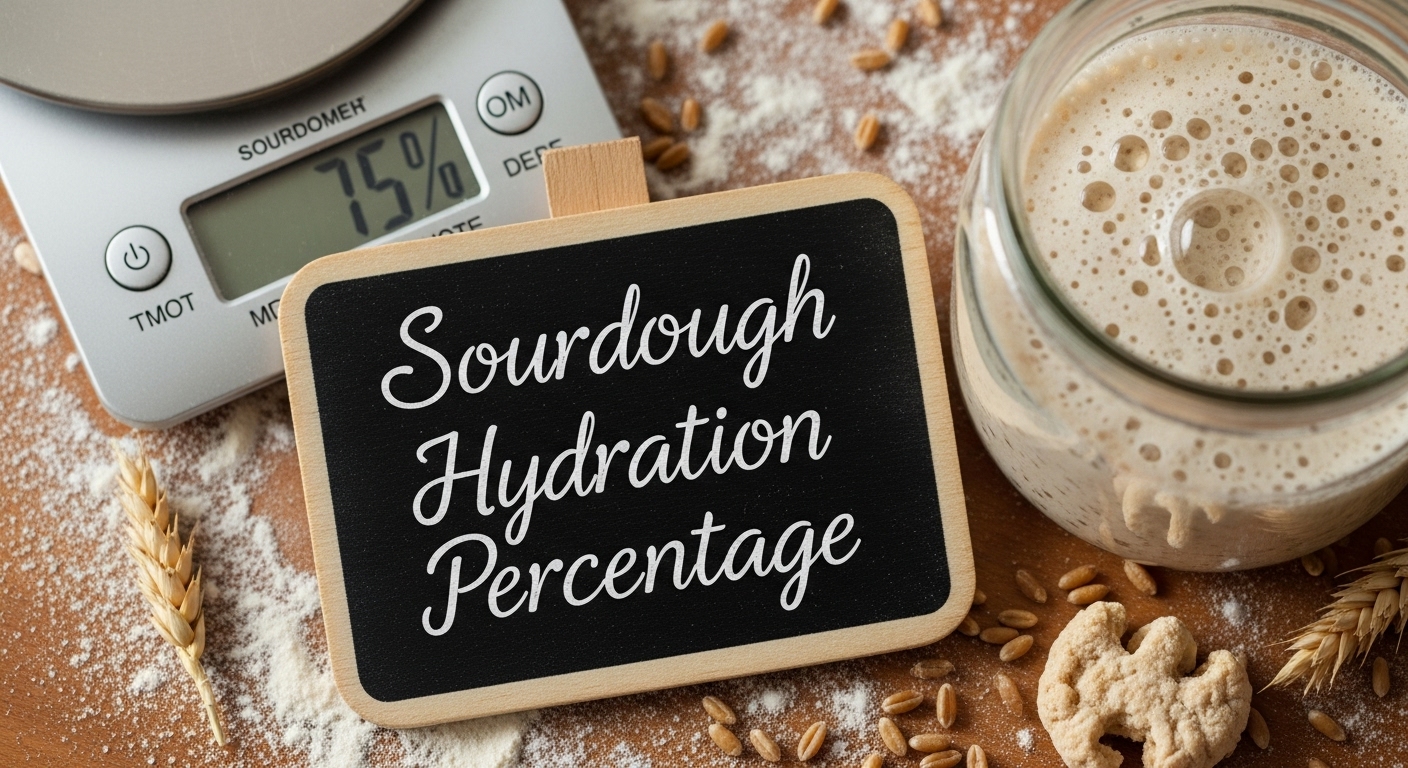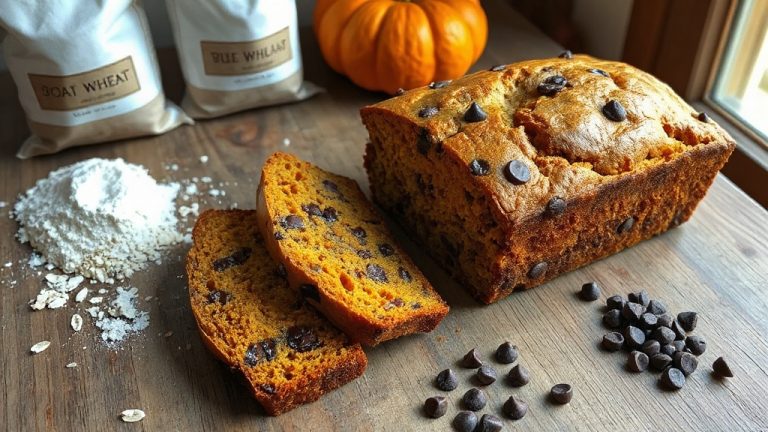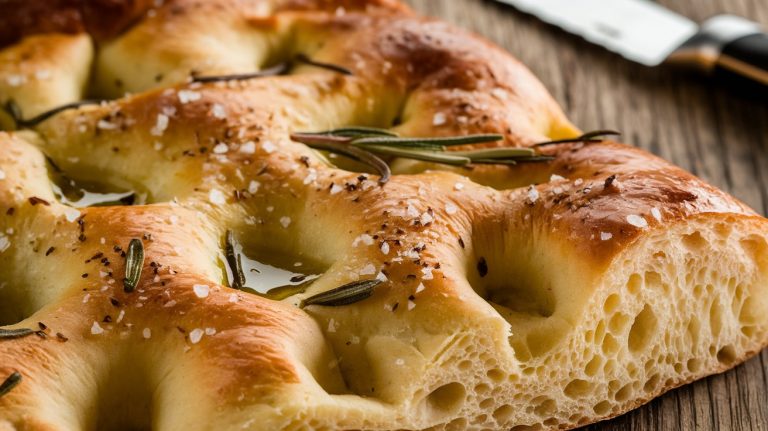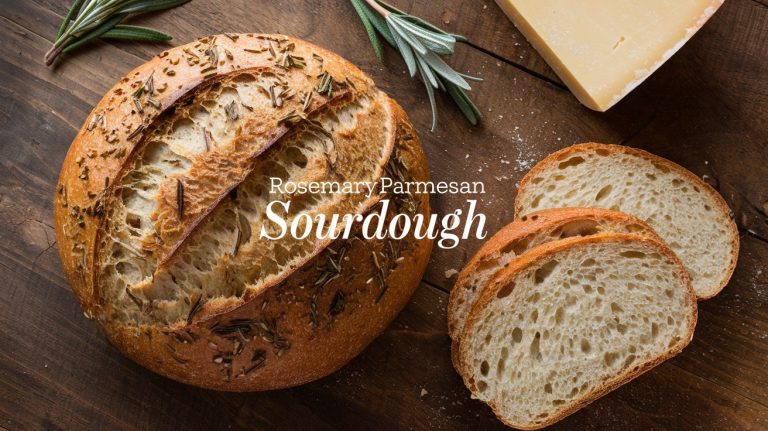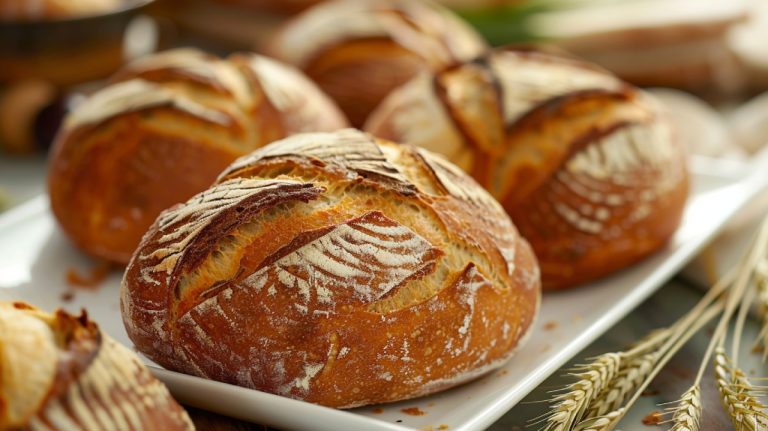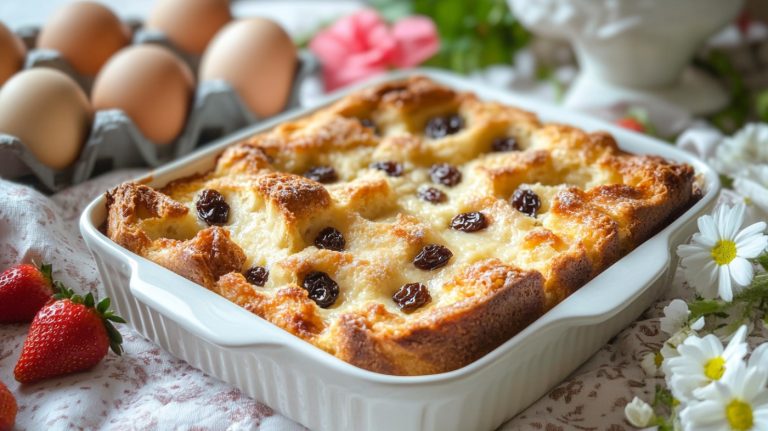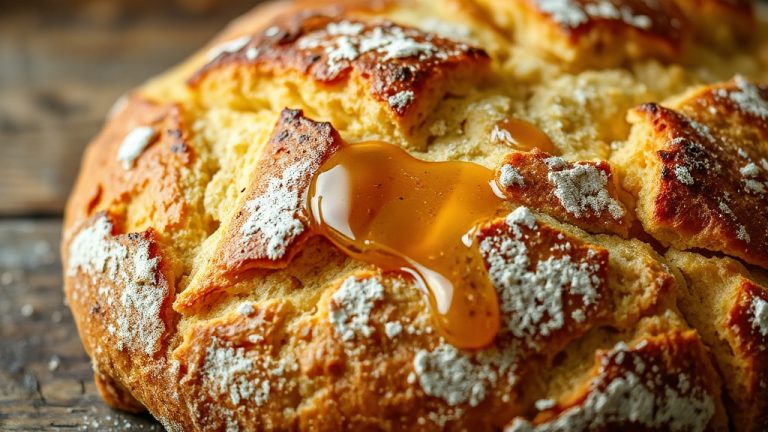Sourdough Hydration Calculator for Achieving the Perfect Crumb
You can calculate sourdough hydration by totaling all the water and flour weights, including your starter’s contribution, and then dividing water by flour to get a percentage. Remember, starter hydration influences this total—you’ll need to adjust added water accordingly.
Use a scale for accuracy and factor in your starter’s hydration percentage to maintain consistency. Getting this right ensures your dough’s texture and crumb develop as expected. Keep refining your approach to master hydration control and dough performance.
Key Takeaways
- A sourdough hydration calculator sums all water and flour, including starter, to compute overall dough hydration percentage accurately.
- Input starter weight and hydration to determine the flour and water it contributes before calculating total dough hydration.
- Hydration (%) is calculated as (total water ÷ total flour) × 100, reflecting the precise water-to-flour ratio in the dough.
- Using digital scales and consistent ingredient measurements ensures accurate hydration calculations and reproducible sourdough results.
- Hydration calculators help adjust water quantities based on starter hydration and flour absorption for desired dough texture and crumb.
Sourdough Hydration Calculator Table
| Step | Description / Formula | Example Calculation |
|---|---|---|
| Weigh All Ingredients | Measure the weight of flour, water, and starter (and note the starter’s hydration percentage) using a digital scale. | Flour: 500g, Water: 350g, Starter: 100g @ 80% |
| Calculate Starter Flour and Water | Split starter into its flour and water components: – Starter Flour = Starter weight / (1 + Starter Hydration %) – Starter Water = Starter weight – Starter Flour | Starter Flour = 100g / 1.8 = 56g Starter Water = 100g – 56g = 44g |
| Total Flour | Add recipe flour + starter flour | 500g + 56g = 556g |
| Total Water | Add recipe water + starter water | 350g + 44g = 394g |
| Calculate Hydration (%) | Use formula: Hydration (%) = (Total Water ÷ Total Flour) × 100 | (394 ÷ 556) × 100 = 70.9% |
| Adjust Water for Target Hydration | If aiming for a specific hydration, recalculate: Additional Water Needed = (Target Hydration × Total Flour) – Starter Water – Recipe Water | For 75%: (0.75 × 556) = 417g, So, add water = 417g – 44g (starter) – 350g (recipe) = 23g more water |
| Finalize Recipe | Adjust water/flour as needed for your target hydration. | Add or subtract water for desired dough texture |
About Sourdough Hydration Percentages
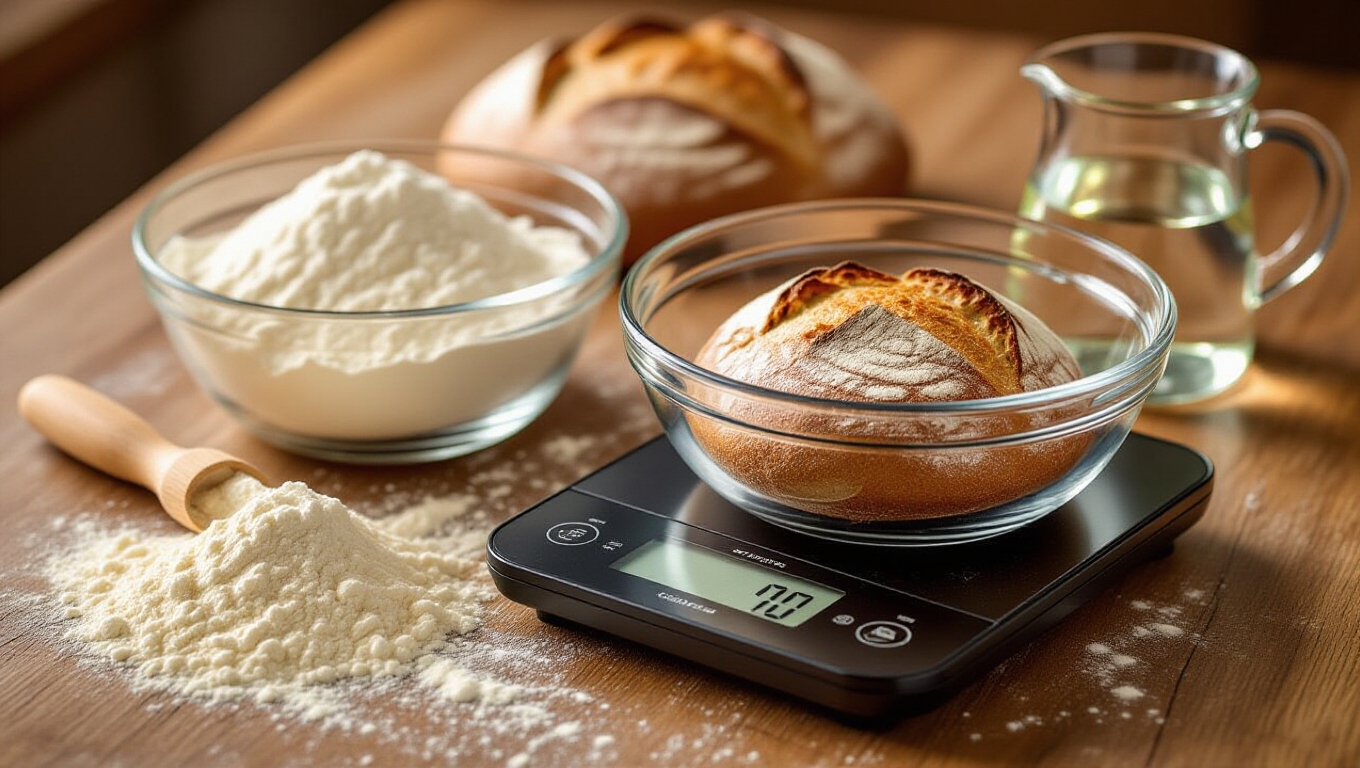
How does hydration affect your sourdough? Hydration is the ratio of water weight to flour weight in your dough, expressed as a percentage. It critically influences dough texture, crumb structure, and final bread quality. Using a precision baking scale ensures you measure ingredients accurately to achieve your desired hydration.
Hydration—the water-to-flour ratio—shapes your sourdough’s texture, crumb, and overall quality.
Typical hydration ranges from 60% to 90%. Below 65%, your dough will be stiff, producing dense, chewy bread with a thick crust. Above 80%, expect a wetter, stickier dough with open crumb and softer texture. Hydration levels also affect the crumb openness and crust thickness of the bread.
To calculate hydration, divide total water weight—including water in your starter—by total flour weight, then multiply by 100. Accurate calculation helps you adjust recipes and predict dough behavior.
Mastering hydration lets you control fermentation, dough handling, and the bread’s flavor profile, ensuring consistent, desirable results with each bake.
Calculating Hydration With Different Starter Hydration Levels
Adjusting sourdough hydration requires factoring in the water and flour contributed by your starter, which varies in hydration levels. To calculate total dough hydration accurately, first determine the flour and water in your starter by dividing its weight by (1 + hydration percentage).
For example, a 100g starter at 80% hydration contains about 56g flour and 44g water. Add these amounts to your recipe’s flour and water totals before calculating overall hydration. This approach helps avoid common issues such as texture inconsistencies often experienced by bakers using mixes like Krusteaz Sourdough Bread
Mix. If you switch starter hydration—say from 100% to 50%—modify added water accordingly to maintain target hydration. Remember, starter percentage relative to total flour affects these calculations, so factor that in. Using precise calculations or hydration calculators ensures consistent dough properties like extensibility and crumb texture.
The recommended salt amount is typically calculated as 1.8% of total flour weight to balance flavor and fermentation in sourdough recipes.
Adjusting Water Amounts for Target Hydration
To adjust water amounts for your target hydration, you need to calculate the total flour and water, including contributions from your starter. Proper hydration also influences the dough’s ability to expand and develop an optimal crust through techniques like scoring.
Remember that starter hydration affects both water and flour totals, so you must factor it in to maintain accuracy.
Precise measurements are essential for consistent results in sourdough baking, as even small deviations can significantly impact dough behavior and final bread quality.
Use the formula: additional water equals target hydration times total flour minus starter water, ensuring precise dough consistency.
Calculating Water Requirements
When targeting a specific hydration level, you’ll need to calculate the total water required by combining the water in your recipe with that contributed by the starter, then adjust the added water accordingly.
Start by summing the flour and water weights from both the recipe and the starter—remember, with a 100% hydration starter, flour and water are equal, simplifying this step. This method is similar in precision to measuring ingredients for a sourdough peach cobbler.
Use the formula Hydration (%) = (Total water ÷ Total flour) × 100 to determine your current hydration.
To reach your target hydration, either increase or decrease the added water while keeping total flour constant.
Use precise weight measurements and consider flour types and starter hydration variations.
Incrementally adjust water and record changes to maintain consistent dough performance.
Keep in mind that hydration percentage reflects the ratio of water relative to all flour, not to the total dough weight.
Starter Hydration Impact
Since starter hydration directly influences the water and flour content contributed to your dough, you’ll need to recalculate the added water to hit your target hydration accurately. For example, a 100% hydration starter adds equal parts water and flour, so the water in the starter counts toward your dough’s total hydration.
This is because the hydration ratio determines how much water is available for fermentation and dough consistency. If you use a stiff starter (50-65% hydration), it contributes less water, requiring you to add more water to maintain your desired dough hydration. Conversely, a liquid starter (>100% hydration) adds extra water, so you’ll reduce the recipe’s added water accordingly.
Adjusting water amounts based on starter hydration ensures consistent dough texture and fermentation behavior. Accounting for these differences is essential for precise dough handling, predictable fermentation, and achieving your intended crumb and flavor profile. Proper hydration also plays a key role in preventing common issues like crust cracking and maintaining dough elasticity during kneading.
Practical Effects of Hydration on Dough and Crumb
As you adjust hydration, you’ll notice how dough texture shifts from firm and easy to shape at low hydration to sticky and extensible at higher levels. These changes directly influence crumb structure, with increased water promoting larger, irregular air pockets.
However, experiments show that hydration level does not significantly alter open crumb formation in sourdough. Mastering handling techniques becomes essential to shape high-hydration doughs without collapsing their delicate network. Proper stretching and folding during the rising process can improve dough strength and texture, helping manage higher hydration levels effectively.
Dough Texture Variations
Although hydration levels vary widely, they directly determine your dough’s texture and handling properties. At low hydration (50%-60%), expect firm, less sticky dough that holds shape well, making it easier to shape and score. This results in a dense, tight crumb and chewier texture, ideal for structured loaves. Low hydration doughs are typically firm and soft, allowing for intricate shaping and a slower fermentation process.
Medium hydration (60%-70%) balances extensibility and stickiness, offering manageable dough with moderately open crumb and softer texture suitable for daily baking.
High hydration (above 80%) creates very sticky, slack dough requiring wet-dough techniques; it yields an open, irregular crumb with airy texture and enhanced gluten extensibility. Handling shifts from kneading to folding as hydration rises.
Adjust your technique accordingly to maintain control and optimize dough development based on these hydration-driven texture variations.
Crumb Structure Impact
When you increase hydration above 70%, your dough develops a more open crumb with larger, irregular holes typical of artisan sourdough. This happens because higher hydration enhances gluten extensibility, allowing gas bubbles to expand freely during proofing.
Open crumb is coveted for its representation of a well-executed sourdough loaf. Additionally, sourdough’s longer fermentation process enhances digestibility and flavor complexity, making hydration management even more critical.
To optimize crumb structure, consider these key factors:
- Hydration Level: Aim between 70-85% for a balance of openness and dough strength; exceeding 80% demands strong flour due to water absorption limits. Using bread flour, which has higher protein content, supports gluten development at these hydration levels.
- Fermentation: Higher hydration accelerates enzymatic activity and yeast mobility, promoting extended fermentation and complex flavor development. This process also benefits from the presence of probiotics inherent in sourdough fermentation.
- Structural Integrity: Excess water weakens gluten, risking crumb collapse and gumminess; maintain proper flour-to-water ratios to avoid this. Maintaining dough stability is essential to preserve the hearty crust characteristic of sourdough bread.
Handling and Shaping
Increasing hydration to achieve an open crumb directly affects how you handle and shape your dough. Higher hydration dough (70%+) is wetter and stickier, demanding quick, confident motions and tools like bench knives to prevent sticking. You’ll need to pre-shape gently, build surface tension carefully, and avoid tearing by letting the dough move with your hands.
Balancing extensibility and elasticity is vital; too slack dough spreads instead of rising, while adequate gluten development maintains shape. Using techniques that prevent overmixing can help maintain the dough’s texture and rise. The type of flour you use can significantly influence how sticky and extensible your dough feels, so adjusting your technique accordingly is important.
| Hydration Level | Handling Traits | Shaping Tips |
|---|---|---|
| 50%-60% | Firmer, easy to handle | Standard shaping |
| 60%-70% | Moderate stickiness | Pre-shape, build tension |
| 70%-80% | Sticky, loose | Quick motions, bench knife |
| 80%+ | Very wet, challenging | Strong gluten, gentle fold |
Tools and Techniques for Accurate Hydration Calculation
To achieve precise sourdough hydration, you must account for all water and flour contributions, including those from your starter or levain. Ignoring starter hydration skews calculations and affects dough consistency.
Use these tools and techniques for accuracy:
- Advanced Hydration Calculators: Input total flour and water weights, including starter components, to get exact hydration percentages, especially when starter hydration varies. For optimal results, ensure your measurements are taken using food-safe gloves to maintain hygiene and prevent contamination.
- Manual Calculation Method: Calculate hydration as (total water ÷ total flour) × 100, summing water and flour from both main dough and starter. Including the starter in these calculations is crucial as it can significantly impact hydration.
- Digital Scales: Weigh all ingredients, including starter flour and water, precisely to guarantee reliable data for calculations.
Common Challenges in Measuring and Maintaining Hydration

Accurately measuring and maintaining sourdough hydration involves steering through several common challenges that impact dough consistency. You must account for flour absorption variability, precise weight measurements—including starter hydration—and environmental factors like humidity.
Additionally, dough handling and fermentation dynamics alter hydration perception, complicating exact maintenance. Understanding the total moisture content as a ratio of water to flour is essential to calculate and maintain the correct hydration percentage. Using bread flour with its specific protein content can influence water absorption and dough texture.
| Challenge | Cause | Solution |
|---|---|---|
| Flour Absorption | Type, protein, freshness | Adjust water experimentally |
| Measurement Accuracy | Scale precision, starter mix | Use digital scales, include all liquids |
| Environmental Effects | Humidity, temperature | Adjust water post-autolyse |
| Dough Handling | Mixing, autolyse, fermentation | Standardize techniques |
| Consistency | Ingredient, environment variance | Tighten controls, document changes |
Frequently Asked Questions
How Does Sourdough Hydration Affect Fermentation Time?
You’ll find that higher sourdough hydration speeds up fermentation because more water boosts yeast and bacteria activity, accelerating biochemical reactions.
Conversely, lower hydration slows fermentation, extending bulk proofing time.
Keep in mind, overly hydrated dough risks over fermentation, causing stickiness and handling issues.
Adjust your fermentation monitoring accordingly, watching dough expansion and bubbles closely to avoid spoilage while optimizing proofing duration based on your dough’s hydration level.
Can Hydration Levels Influence Sourdough Flavor Development?
Did you know that increasing hydration from 60% to 64% can considerably boost lactic acid bacteria activity, enhancing sour flavor complexity?
When you adjust hydration levels, you directly influence microbial metabolism and acid production. Higher hydration promotes active fermentation, generating more organic acids and volatile compounds, enriching sour profiles.
Conversely, lower hydration slows microbial activity, limiting acid buildup and flavor depth. So, precise hydration control is essential for optimizing sourdough flavor development.
What Is the Ideal Hydration for Whole Grain Sourdough?
You’ll want to target 75%-85% hydration for whole grain sourdough. Start around 75%-80% for a manageable dough that balances moisture with handling ease.
If you aim for a lighter crumb and better rise, push hydration closer to 85%, but be prepared for stickier dough requiring careful technique.
How to Adjust Hydration in Humid Versus Dry Climates?
In humid climates, reduce your dough’s water by 2-5% of the flour weight to prevent overly slack dough, as flour absorbs more moisture from the air.
In dry climates, increase hydration by 5-10% to compensate for less ambient moisture and faster evaporation.
Always consider your starter’s water content and monitor dough feel—sticky means too wet, crumbly means too dry.
Adjust water temperature to maintain ideal fermentation temperature between 75-78°F.
Does Hydration Impact Sourdough Crust Thickness?
Yes, hydration directly impacts sourdough crust thickness. When you increase hydration, your crust tends to be thinner and crispier due to more steam released during baking, which softens the crust surface.
Lower hydration produces a thicker, chewier crust because the dough holds its shape better and caramelizes more. Adjust hydration carefully, balancing dough handling challenges with your desired crust texture to optimize your loaf’s final crust thickness and crumb softness.
Sourdough Science: How Hydration Transforms Your Bread
Mastering sourdough hydration is key to achieving your desired dough texture and crumb structure. Remember, typical hydration ranges from 65% to 85%, with higher percentages producing a more open crumb.
When calculating hydration, always factor in your starter’s hydration level to maintain accuracy. Using precise measurements and reliable tools will help you consistently hit your target. By understanding and controlling hydration, you’ll elevate your sourdough baking from good to exceptional every time.

